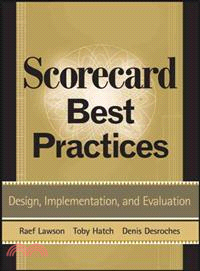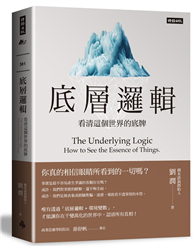| FindBook |
有 1 項符合
SCORECARD BEST PRACTICES的圖書 |
 |
SCORECARD BEST PRACTICES 作者:RAEF LAWSON / 譯者:TOBY HATCH 出版社:JOHN WILEY & SONS,LTD 出版日期:2007-10-24 規格: / 精裝 / 208頁 |
| 圖書館借閱 |
| 國家圖書館 | 全國圖書書目資訊網 | 國立公共資訊圖書館 | 電子書服務平台 | MetaCat 跨館整合查詢 |
| 臺北市立圖書館 | 新北市立圖書館 | 基隆市公共圖書館 | 桃園市立圖書館 | 新竹縣公共圖書館 |
| 苗栗縣立圖書館 | 臺中市立圖書館 | 彰化縣公共圖書館 | 南投縣文化局 | 雲林縣公共圖書館 |
| 嘉義縣圖書館 | 臺南市立圖書館 | 高雄市立圖書館 | 屏東縣公共圖書館 | 宜蘭縣公共圖書館 |
| 花蓮縣文化局 | 臺東縣文化處 |
|
|
- 圖書簡介
Scorecard Best Practices: Design, Implementation, and Evaluation expertly shows you how to bridge the gap between Scorecard theory and application through hands-on experiences and useful case studies. It is the one-stop resource you will turn to for the latest tools and know-how to implement corrective changes. Whether you are a CEO, CFO, CIO, vice president, or department manager, Scorecard Best Practices is the book you will keep at your fingertips to get your company running at maximum performance.
- 作者簡介
Raef Lawson, PhD, CPA, CMA, is Director of Research for the Institute of Management Accountants (IMA). He was formerly a professor and chair of the Accounting Department at the University at Albany, State University of New York. He has written extensively in the areas of scorecards, activity-based costing, and cost management, and his work has been published in a variety of publications.
Toby Hatch is a Domain Leader for Performance Scorecard and Business Modeling with Hyperion Solutions. Ms. Hatch has been involved with supporting and implementing scorecard systems, performance management solutions, and activity-based management solutions in companies around the world since 1988. Based on five years of research on implementing scorecard systems, she has published numerous articles in various magazines.
Denis Desroches is a Domain Leader in the business performance management field with Hyperion Solutions. Since 1993, he has supported organizations with the selection, implementation, and knowledge acquisition of scorecard, performance management, and activity-based management solutions. - 目次
Acknowledgements.
Chapter 1. Introduction.
Shaps Study Overview.
Study Analysis Groups.
Chapter 2. Scorecard Systems Overview.
What Is A Scorecard System?
Attributes Of Scorecard Systems.
Reasons For Implementing (Operational Versus Strategic).
Impetus For A Scorecard System Initiative.
Benefits Of A Scorecard System.
Best Practice Organization Benefits.
Achieving Significant Benefits: International Results.
Use Of Scorecard Systems By Demographic Segment, Size, Industry
What's Next?
Chapter 3. Establishing Motivation.
Background.
Impetus For Implementation.
Use Of Targets.
Linking Performance Measures To Compensation And Rewards.
Aligning Measures And Employees To Organizational Goals.
Advertising Success.
Measures Used.
Software Features Made Available.
Communicating Appropriate Reasons For Scorecard Implementation.
Summary.
Chapter 4. Enabling A Supportive Organizational Environment.
Background.
Have Buy-In From Top Level Management.
Articulate And Communicate The Organizational Strategy.
Define And Communicate The Reasons For And Benefits Of Implementing A Scorecard System.
Align Human Capital To The Strategy.
Have A Strategy Champion To Maintain The Visibility Required To Be Successful.
Have Employees That Accept And Use The System.
Use A Feedback Loop To Understand Progress And Make Changes Where Required.
Suitable Automation.
Eventually Link To The Compensation And Reward Systems.
Use Consultants Appropriately.
Provide Adequate Time To Implement And Realize Benefits.
Have A System That Is Pervasive, But Implemented In Phases.
Summary.
Chapter 5. Design Of A Scorecard System I: The Organizing Framework.
Organizing Framework.
What Is An Organizing Framework And Why Do We Need One?
Popular Frameworks.
Frameworks Typically Chosen.
Industry Example.
Can An Organization Have Multiple Frameworks?
Multiple Frameworks Or Management Initiatives?
Summary.
Chapter 6: Design Of A Scorecard System II: Other Issues
Background.
Ties Between Measures And Organizational Strategy.
Linking Compensation With Performance.
A Pervasive Scorecard System.
Tracking The "Right" Measures.
Does Your Costing System Support Your Scorecard System?
Self-Evaluation Questionnaire.
Summary.
Chapter 7. Implementation Strategies.
Communicating Scorecard Concepts
Selling The Scorecard.
Organization Levels.
Approaches To Implementation.
Impact Of Implementation Approach.
Industry Differences.
Framework And Levels Of Implementation.
Plans For Future Roll-Out.
Updating Scorecards.
Summary.
Chapter 8. Implementation Issues.
Implementation Timeframe And Deadline.
Implementation Timeframe And Reason For Scorecard System Deployment.
Implementation Timeframe And The Approach.
Effect Of Rationale On Implementation.
Number Of Measures.
Time To Implement Scorecard Software.
Use Of External Consultants.
Consultants And Scorecard Automation.
Organizational Buy-In.
Scorecard And Other Performance/Cost Management Tools.
Summary.
Chapter 9. Scorecard Automation.
Need For Automation.
Extent Of Data And Report Automation.
Software Options.
Software Deployment.
Reporting Results.
System Functionality And Features.
System Flexibility.
Data Accessibility.
Summary.
Chapter 10. Best Practice Considerations Checklist.
Best Practice Considerations Checklist.
Appendix. Case Studies.
Suzano Petroquimica.
Fujitsu Services Oy.
First National Bank: Banking Operations.
Hospitality Services Company.
Financial Service Company.
Pfizer.
City Of Boston.
Entertainment Subscription Company.
Glossary.
Index.
Acknowledgments.
零的代價:中國在新冠疫情期間和其後的政策失誤
江恩角度K線:華爾街交易成功率90%的投資傳奇,用166張K線圖教你看出支撐與壓力,抓住波段買賣點,暴賺5000萬美元!(熱銷再版)
會計學歷年試題+模擬考
會計學完全攻略
自由選擇背後的行為賽局:讀哪間學校、跟誰結婚、是否生小孩、想與誰為鄰……諾貝爾經濟學獎得主教你繞開從眾偏誤,在人生關鍵時刻做出最佳決定
第1名業務養成術:成為業務神人的10大關鍵
別再看股價了!:每次查看股市都賠錢?最簡單的投資策略,每年交易4次就能選中贏家!
不動用武器的戰爭:資源、貿易、數據,交織全球經濟大戰略
5年從零到500萬的理想生活:5千元就能開始!克服月光和漏財,不壓抑需求也讓資產成長有感
|











